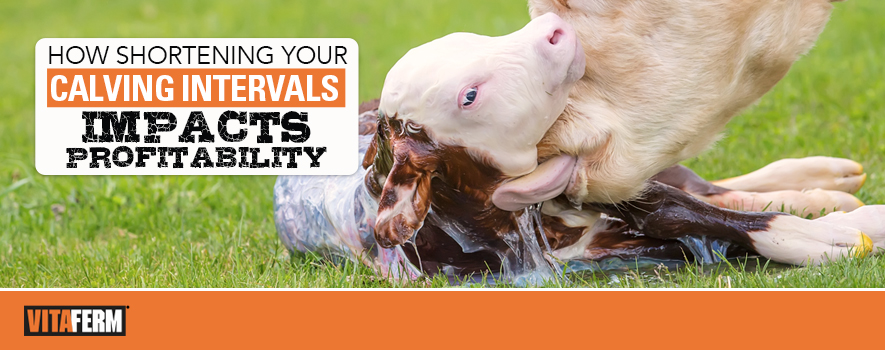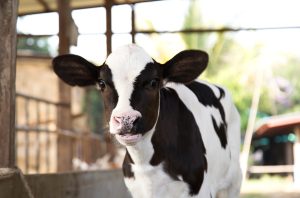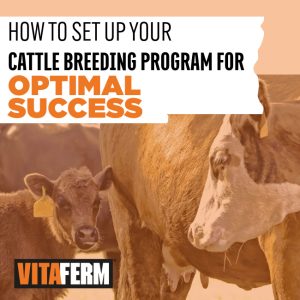
When it comes to your cow herd’s reproductive performance, shortened calving intervals should be a proactive part of your management protocol. But, did you know that the fewer days you calve each year, the more profit potential you are looking to add back into your pocket book? There are several ways that shortening your calving period one or even two cycles can help impact profitability of your herd.
Perhaps the most evident impact to increased profitability will come at weaning time, when you sell your calves. Calves that are born in a tighter window will be more uniform in size and weight and will be more ideal for load lots, which often receive a premium when buyers don’t have to gather up small groups of calves from multiple sellers. Groups that are more uniform in size won’t have a “pecking order” where smaller calves are pushed away from the bunks, therefore hurting their gain and performance.
Consider this example. If a calf typically gains 2-3 pounds per day, it will gain an additional 52.5 pounds per 21-day breeding cycle. That means, if you shorten your calving window to 60-days, calves born in that first cycle will weigh 105 pounds more at weaning than calves born in the last cycle. Calves at weaning average $1.50 per pound, so you have already increased your profits by $157.50 per calf from that first calving window vs. those in the last group.
2.5 pounds gain/day x 21 days = 52.5 pounds
52.5 pounds x 2 calving cycles (21 days each) = 105 pounds
105 pounds x $1.50/pound at weaning = $157.50 more than those calves born in the last 21 days
“Granted not all of your cows will get bred in those first 21-days, but if you are on a good nutrition program, at least 70-percent of your cows should breed to calve in the first cycle, 20 percent should come in the second cycle and the rest should breed that last cycle,” said Kevin Glaubius, Director of Nutrition for BioZyme® Inc.
In addition to added profit at weaning, producers will realize other cost saving benefits to shortened calving intervals. Strategic herd management means an increased concentration of labor, where animal husbandry is more focused on similar stages of production at the same times and for shorter times, such as breeding, calving, calf care, and the labor efforts for these duties are not spread out over long periods of time.
Finally, a tighter calving interval helps determine those cows that are superior reproductively speaking. If you have cows that can’t breed in a shortened window, they need to be culled, and there is added expense of replacing those breeding females in the herd compared to the value of selling cull cows.
Understanding the economic value of a shortened calving interval is exciting. However, getting those windows shortened to achieve economic gain comes with some work. As Glaubius previously mentioned, reproductive success in the cow herd begins with a good nutrition program. BioZyme offers a line of vitamin and mineral supplements specifically designed to help improve the reproductive success of the cow.
VitaFerm® Concept•Aid® helps cows ensure reproductive success on two levels. First, it provides a completely fortified vitamin and mineral package to the cows to make sure they have the nutrients they need at the most critical time of their production cycle – calving, lactation and breeding.
“The vitamins and minerals are key to keeping animals healthy, fighting off stress and cleaning out,” Glaubius said. “Those high levels of fortification and trace minerals help that cow start cycling back earlier.”
Secondly and perhaps just as important, Concept•Aid serves as a mechanism to deliver the additive Amaferm® to the diet. Amaferm is a precision-based prebiotic found in all BioZyme products and is research-proven to increase intake, digestibility and absorption. Prebiotics are especially important to digestive health and therefore overall health because they help the livestock adapt to a very diverse microbiome in the digestive tract and fight the battle between good and bad bugs.
“Typically, the cow loses weight the first 30 days post-calving, but when we add Amaferm to that mineral, it allows her to process feed faster, allows her to consume more and to get back into a positive energy balance that signals to her body that she is ready to get back into a reproductive state. We have to give Amaferm a ton of credit for helping return that energy balance to the cow,” Glaubius said.
In a time when production costs and looking for the least-cost feed options are top-of mind, doesn’t it make sense to feed a prebiotic like Amaferm that increases digestion and absorption, making your feed resources stretch further? You’re likely already feeding a vitamin and mineral supplement, but with the advantages that Amaferm offers, you should consider VitaFerm Concept•Aid. A 50-pound bag of Concept•Aid is approximately $8 more per bag compared to other minerals without the prebiotic. At recommended feeding rates, there are approximately 200 feedings per bag, making Amaferm about 4 cents per cow, per day.
BioZyme recommends feeding Concept•Aid 60 days pre-calving to 60 days post-breeding. If you calculate 4 cents per day for 165 days, you’ve just invested $6.60 in your cow to help increase her reproductive efficiency. If you are bulk mixing feed, you can add one bag of the supplement per three tons of feed, spreading the cost even more, to $2-$3 per ton. You’re already feeding mineral, you might as well include a prebiotic that can do so much more to help your herd and help your overall profitability. Remember for that $6.60 per cow investment, you are likely to wean a calf that will bring an added $157.50 at weaning, making that investment in Amaferm worthwhile.
You’re making good decisions and providing a good nutrition program to your cow herd. It only makes sense to invest in a prebiotic like Amaferm to help your cows increase their reproductive efficiency. Adding Amaferm will help you tighten your calving intervals and add profitability to your herd.


